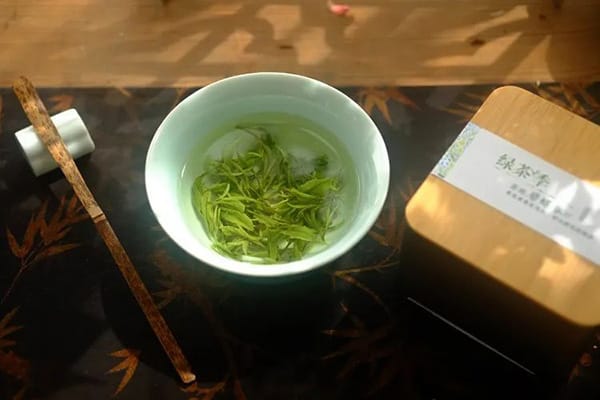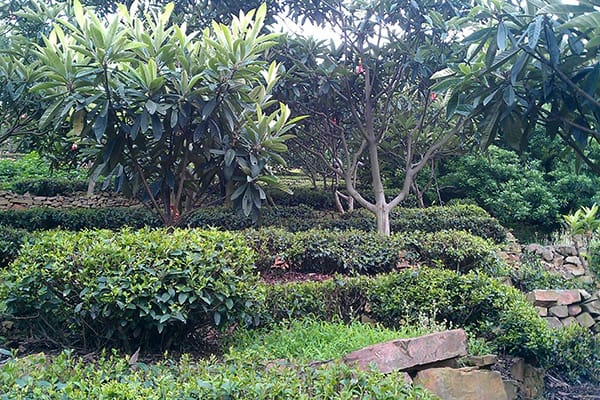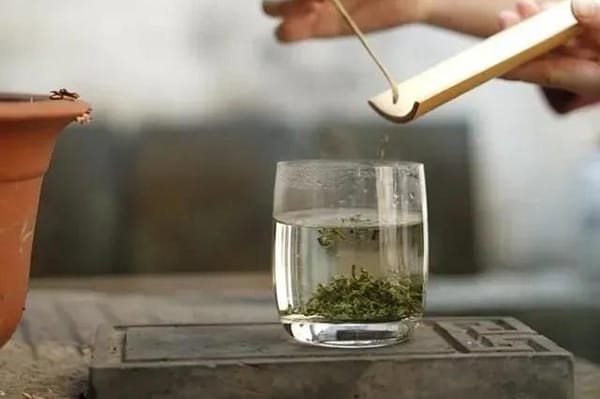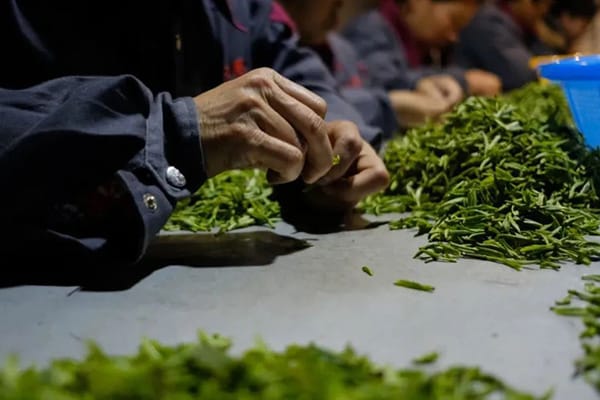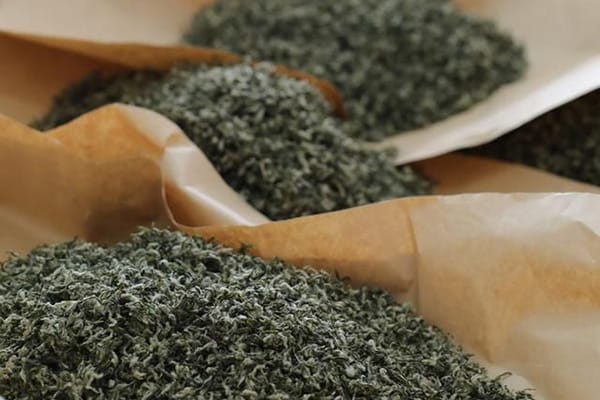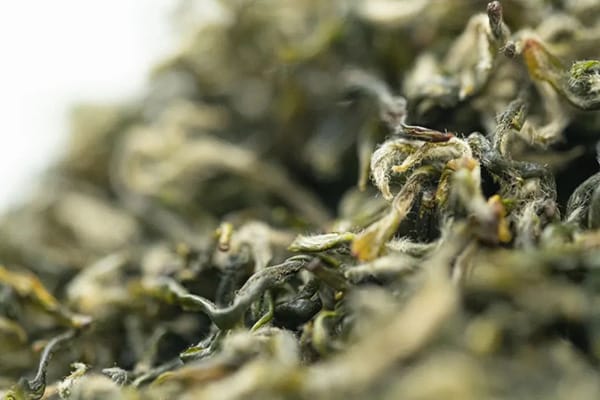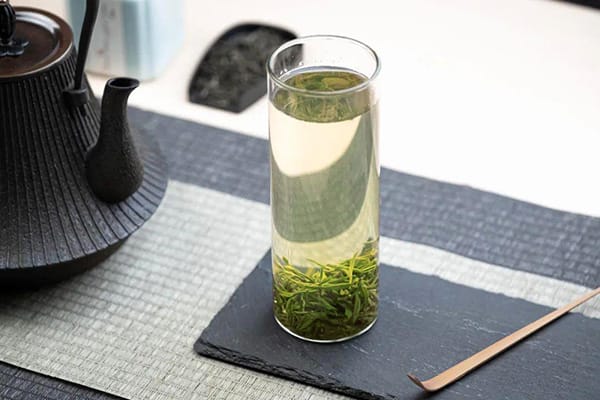Last Updated on 05/30/2021 by Desmond
Green tea lovers may ever hear about Biluochun, which is one of the Chinese 10 famous teas. It looks like an emerald, curly caterpillar, full of tiny white fuzz. Biluochun is made from the tenderest buds shoot in the early spring. It is said that the most top-grade one costs 60-70 thousand buds per 0.5kg, so it consistently at a high price.
CONTENT
What Is Biluochun Tea
Biluochun tea is originated in Dongting Mountain of the Taihu region, Jiangsu, also called Dongting Biluochun. That place has over a thousand years of tea-producing history, and it is said that tea produced here is always as a royal tribute since Tang Dynasty. Biluochun has a full fruity aroma. As a kind of green teas, this is uncommon. In the past time, due to this great aroma, Biluochun is also called “Xia Sha Ren Xiang“(a robust fragrant to shocking people.)
Names Legends
Biluochun is pronounced /biː/, /lɔ:/, /tʃʌn/. About this name, there are 3 explains.
The most realistic saying is the name comes from the tea’s appearance and characteristics. In Chinese, “Bi” means green; “Luo” describes the leaves’ spiral shape, looks like the pattern of the trumpet shell; and “Chun” refers to spring.
One of the legends is about beautiful love. It is said that there was a boy named Xiang who lived in the east Dongting Mountain, and a girl named Biluo lived in the west side; they were in love. But one day, an evil dragon appeared in Taihu Lake, and he wants to grab the girl as his bride. The boy fought with the dragon to save his love. Finally, they both down.
Girl Biluo didn’t give up. She picked up leaves and making them into tea as a medicine for curing her boy. Finally, the boy recovered. But the girl was unlucky; she died because of overwork. The boy was so sad, then he took care of the tea tree, which saves his life, and names it Biluo, to remember the girl forever.
Another story tells, there was a bumper harvest of tea in Taihu producing region. A girl found her basket was full when she was still picking leaves, so she stored the leaves in her dress. After she came home and took out the leaves, she found them sending a great aroma because of the heat of her body. The girl was shocked and shouted, “This aroma is too terrifying!” Since that, the local people have called this tea “Xia Sha Ren Xiang.”
Later, the Kangxi Emperor went to Taihu for inspecting, and the local official served him with the tea. Kangxi loved the tea much, but he thought that the name is no so elegant and did not match its characteristics. So he granted this tea a new name Biluochun.
Producing Regions
No matter how the legends say, Biluochun is no doubt originated in the Dongting Mountain of Taihu. Worthing to know, people may easily confuse this place with the Dongting Lake in Hunan; that is the origins of the Junshan Yinzhen yellow tea. And Biluochun’s fame is too big indeed, many other places in China also producing it. But only the one made from the Taihu Dongting Mountain is regarded as the most authentic by tea lovers.
The region is also divided into east Dongting Mountain and west Dongting Mountain. The east one is a peninsula near Taihu Lake, and the west one is a small island in the lake. The climate is humid subtropical monsoon, moist and warm, and an excellent natural environment suitable for the tea trees growing.
Suppose you wonder what contributes to the excellent flavor of Biluochun tea. In that case, one of the biggest reasons is its unique planting way. In Biluochun tea plantations, there are not only tea trees, but many varieties of fruit are planting; waxberry, pipa, bergamot, peach, and so on.
Due to the Biluochun primary harvest season is spring, and the leaves quality is not so good in the other seasons. Planting fruit trees can help the local farmers earn more money. The teas and fruit trees grow side by side, roots and branches are twisted together, share the nutrient and flavor. So Biluochun tastes with a fruity flavor, and it’s rarely among all the green teas.
Camellia Sinensis Varieties
Biluochun’s source leaves are primary from 3 varieties of tea trees.
Native Species. This is a kind of native small-leaf Camellia Sinensis. The Biluochun tea produced from it is regarded as the most authentic. It sprouts relatively late, typically can’t be harvested until Qingming (5th April.) But it tastes the most mellow and with the most outstanding flavor.
Xiaoshan Species. This tea tree is bred from the native species, origins in the Xiaoshan Island, and a relatively new type. It sprouts early, typically can be harvested in the middle of March so that the product can be published earlier and get a higher price.
Wuniu Species. It’s a newly introduced tea tree from another place. The feature of it is sprout very early, typically can be harvested in early March. But it tastes weaker and not resistant to brew.
Maybe you will think that the native species will be the most welcome. But the truth is the opposite. Most tea lovers pursue tender bud tea, especially the market’s vigorously promote of Mingqian Cha and Yuqian Cha. That makes the tea can get a higher price if published earlier. Sometimes the price spread even over double.
Tea factories will start purchase source leaves in March, processing them into teas, and make sure they can be published before April. So the Wuniu species which sprouts earliest is more welcomed by the tea farmers; it brings more earning.
The exotic species tea trees have got over 80% occupancy in the Dongting Mountain producing region in recent years, and the native ones left less than 20%. Some tea farmers even cut down the native tea trees in their own plantations to plant more Wuniu species. It leads to the yield of the authentic Biluochun reduction, and tea lovers need to pay more to buy.
Even so, Biluochun is really too famous, and it never satisfied the market requirement, no matter whether it is native or not. Some local tea factories even purchase the leaves from other places for processing, then sold with the Biluochun brand. That is how the various Biluochun with a low price come, and their flavor is far away from the authentic ones.
Elaborate Processing
The traditional Biluochun processing is all in manual by tea masters. Tea masters’ extraordinary skills give Biluochun a unique appearance and flavor. As one of the most expensive green tea, every step during Biluochun processing requires the best.
Picking
The picking standard of Biluochun is one bud and the just-bloom first leaf. Harvest typically starts from the end of March, ends before May comes. The leaves picked before Qingmin (5th April) are the most expensive. They are just bloomed, curly like the bird’s tongue. And they are tiny, need dozens of thousands of leaves to produce a kilo Biluochun. Some more rare leaves will be picked before Chunfen(20th March) and only available by pre-order. The leaves picked after Guyu(20th April) are also called “Chao Qing,” typically with a reasonable price.
Screening
Most of the green teas will be fixated after picking immediately to prevent the leaves go on fermenting. But in the Biluochun case, tea masters will screen the leaves first. They remove the leaves that do not match the standard and make the left ones unify at the appearance, size, and quality. This process needs to be very careful, and it cost lots of time, typically more than 6 hours.
During this processing, leaves are a little fermenting inevitably, similar to the withering of White Tea. Some people thought that the fruity flavor of Biluochun is not related to the planting style but this processing.
Fixation
Fresh leaves must be fixated on the same day of picking. Tea masters will put the leaves after screening in a pan at 190-200℃, frying them quickly to stop them from fermenting, also keep the green color. This usually costs 3-5 minutes.
Rolling
One characteristic of Biluochun is the leaves are covered with tiny white fuzz like the white tea. These fuzz which is called “Hao,” are proper of the tender bud teas. The tender the leaves, the more fuzz they get. After fixation, tea masters will lower the pan’s temperature, rolling the leaves with their hands gently, making them into a curly spiral shape. Tea masters need to be very careful so that no let the fuzz drop from the leaves.
Drying
As the frying and rolling ending, the leaves’ water content has reduced a lot, and they look dry. But this dryness is still not suitable for storage, and the tea may get damp and bad quickly. So after rolling, tea masters will put the leaves on paper and place them at the edge of the pan. Use the afterheat to keep drying them, let the water content reduce to an ideal degree.
Biluochun Grades & Flavor
The Chinese authorities set a grading standard for Biluochun tea according to the leaves quality; from the best to the general:
- Special First Grade
- Special Second Grade
- First Grade
- Second Grade
- Third Grade
- Special Grade
- First Grade Chao Qing
The Special First Grade Biluochun must only be made from single buds, which is the most expensive. The First to the Third Grade ones typically with a reasonable price, and they are loved by many senior tea lovers.
The Special and the First Grade Chao Qing Biluochun are made from the leaves that were picked in late April. Its price is low, but the flavor also excellent, suitable for the one who wants to take the first try.
The higher the grade, the infusion of Biluochun shows greener. Vast fuzz will dance in the water, look not muddy, but reflect silver light under the sun. Close to the cup and have a smell, you will get an elegant and fresh floral. Due to the fuzz, Biluochun tastes brisker and with a little astringent. Still, the sweetness aftertaste will come soon, delicate like the pipa. The maturer Biluochun tastes more mellow, a fruity flavor similar to peach, but the astringent and bitter will be more obvious.
How To Make Biluochun Tea
Brewing with a Gaiwan
Use a Gaiwan to brew Biluochun tea is great for sharing with friends.
- Prepare and preheat a 250ml white ceramic Gaiwan;
- Add 80℃ water in first, then put 3-5g leaves in;
- Cover and steep for about 25 seconds;
- Pour the infusion into a fair cup to equal the concentration, don’t left a drop;
- Share it to each cup, enjoy;
- Typically, Biluochun tea can make 5 brews;
Brewing with a Glass Cup
When you want to try Biluochun alone, an ordinary glass cup will be nice.
- Prepare a 300ml glass cup;
- Add 80℃ water in till the 3/5, then put 5-8g leaves in;
- Steep for about 15 seconds, then go on adding water after the leaves are extended;
- Enjoy;
- Refill when the tea almost finish, and not need to wait it all gone;
Store Ways
Even though most Chinese tea lovers pursue the Biluochun tea produced in the early spring, they would not drink it immediately after buying it. Because Traditional Chinese Medicine thought that the tea just finished frying will easily bring “heat” to the human body and leads to inflammation. So they usually store the tea for several weeks, let the “heat” gone, and the flavor become mature, then drinking.
Biluochun tea is rare and expensive, so the products on the market typically with a bit of weight, about 50-200g; you can finish consuming it in a short period. Few people will aging the Biluochun tea because the flavor of the non-fermented green tea will easily change and go bad during long time storage.
To store the Biluochun, you need a non-smell iron or tin container (many products will take them as a packing.) Ensure that the container has good airtightness, and then you can store it in a fridge(0-5℃).
Suppose there are many other foods in the fridge and smell. In that case, you need to wrap a kraft outside the container extra or consider storing the tea in another place. A dark, cold, drying environment will be awesome.
Related Reading: Choose the best tea storage container for loose leaf tea.
